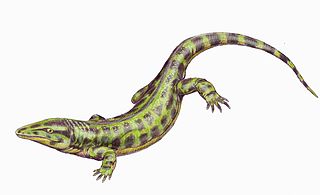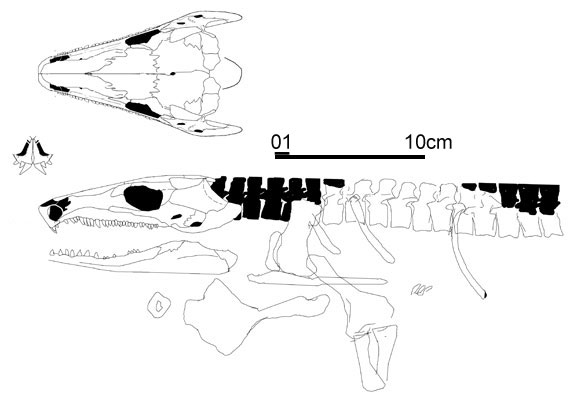
| Palaeos |  |
Reptiliomorpha |
| Vertebrates | Solenodonsaurus |
| Page Back | Unit Home | Unit Dendrogram | Unit References | Taxon Index | Page Next |
| Unit Back | Vertebrates Home | Vertebrate Dendrograms | Vertebrate References | Glossary | Unit Next |
|
Abbreviated Dendrogram
TETRAPODA |--TEMNOSPONDYLI `--+--LEPOSPONDYLI | `--REPTILIOMORPHA |--Anthracosauroidea | `--+--Embolomeri | `--Chroniosuchia `--+--Gephyrostegidae `--Batrachosauria |--Seymouriamorpha `--+--Solenodonsaurus `--Cotylosauria |--Diadectomorpha `--AMNIOTA |
Contents
Overview |

Solenodonsaurus: S. janenschi Broili 1924)
Range: Late Carboniferous (Westphalian D) of Europe.
Phylogeny: Stem Amniota : Casineria + Westlothiana + (Cotylosauria + *)
Size Skull c.13 cm, snout-vent length about 45 cm
Note: The following three fields are copyright Michel Laurin 02 May 2001 (here signed ML010502) adapted from the Tree of Life Page Creative Commons Attribution
Characters: . Shallow temporal emargination (otic notch); humerus fairly robust, with strongly expanded proximal and distal heads. There appears to have been a single sacral rib. Its neural arches were not swollen, unlike those of seymouriamorphs and diadectomorphs. As in many other early stegocephalians, its skin was reinforced by long ventral and circular dorsal, bony scales.. Unfortunately, our knowledge of the skeletal anatomy of this taxon is poor because only a few incomplete skeletons are known. The preserved skulls are also poor. Therefore, the path of some of the sutures on the skull is uncertain. ML010502
Comments: Probably carnivorous or insectivorous, as shown by its sharp, slightly curved teeth. The temporal emargination is shallower than in most other early stegocephalians, and its shape is unsuitable to have supported a tympanum. Thus, Solenodonsaurus could probably not hear high-frequency air-borne sounds very well, if at all. ML010502

Relationships to other tetrapods: Solenodonsaurus was erected and described by Broili (1924), who considered that it was a "cotylosaur" (a group that included some early amniotes and their presumed closest known relatives). Its teeth lack the labyrinthine infolding primitively found in stegocephalians, and this is one of the characters (the other being the morphology of the vertebral centrum) that led Broili (1924) to suggest that this animal was an amniote (a "reptile", in his terminology). Its interclavicle has a long posterior stem, and this has long been thought to unite it with other anthracosaurs, but this character has a broader distribution (Laurin & Reisz, 1997). The vertebral centrum of Solenodonsaurus resembles that of seymouriamorphs, diadectomorphs, early amniotes and some early amphibians. It consists of a large, cylindrical pleurocentrum and a small, crescentic intercentrum. Other characters that were taken as evidence of amniote affinities of Solenodonsaurus are the absence of an intertemporal and the presence of a supraoccipital and of a contact between the tabular and the parietal. However, most of these characters have a broader distribution (Laurin & Reisz, 1997). Subsequent studies confirmed that Solenodonsaurus was either an early amniote or a close relative of amniotes (Pearson, 1924; Brough & Brough, 1967; Carroll, 1970). The advent of cladistics clarified somewhat the position Solenodonsaurus; this taxon was considered to be definitely outside Amniota, but to be closely related to the clade that includes diadectomorphs and amniotes (Gauthier, Kluge & Rowe, 1988). In a recent analysis that included amphibians (Laurin & Reisz, 1999), Solenodonsaurus appears to be the sister-group of all other known anthracosaurs (amniotes and their extinct relatives). ML010502
Image: Life reconstruction by Dmitry Bogdanov - Wikipedia technical illustration by David Peters, Reptile evolution MAK111107
| Page Back | Unit Home | Page Top | Page Next |
checked ATW050518, new page MAK111106